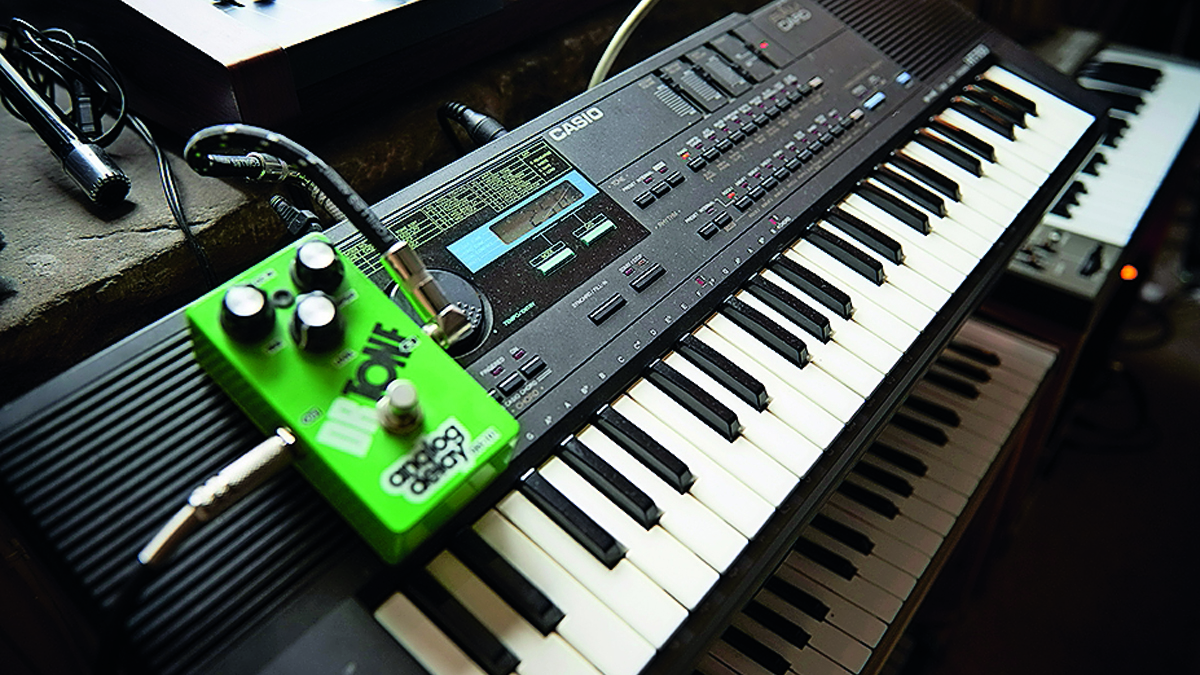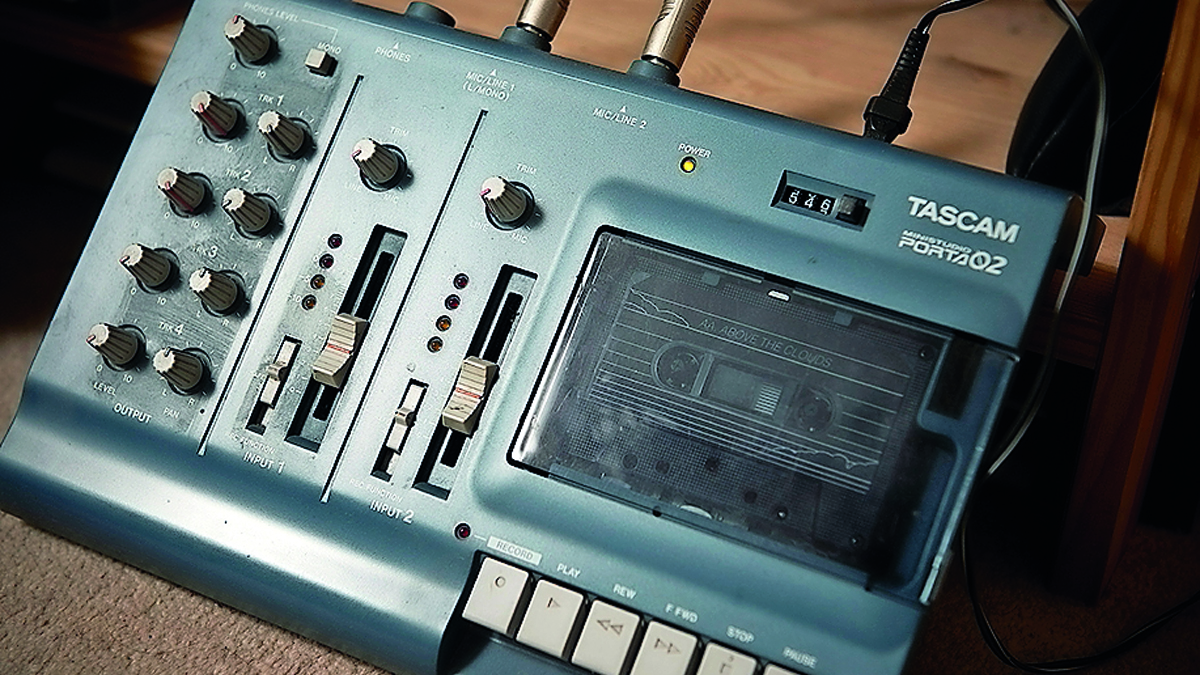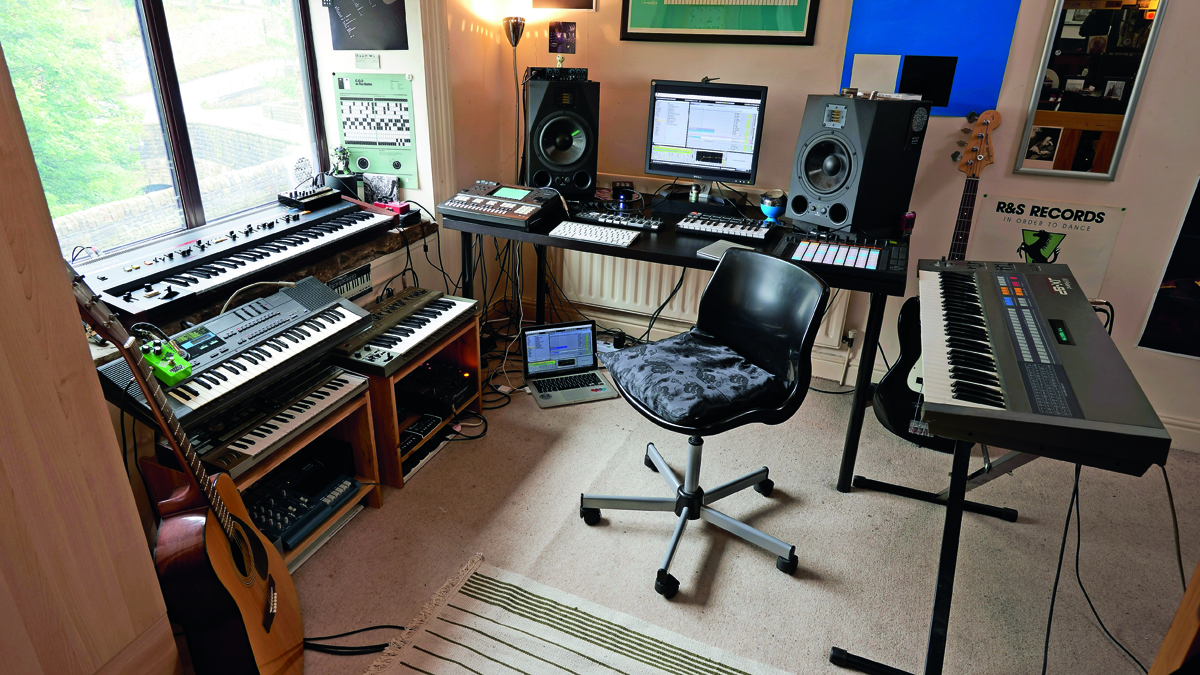In pictures: Synkro's Manchester studio
We discover how his lo-fi studio set-up is no obstacle to producing a modern, expansive sound

Synkro
Relying on software has its drawbacks, as Joe McBride learned when a data crash wiped out years’ worth of samples and sounds that he’d admittedly become over- reliant on. Faced with months of resampling and recovery, his decision to adopt a new way of working, absent of hard drives and data banks, proved to be inspirational.
The result is his debut Synkro album Changes, which pays testament to his newfound love for cheap hardware synths, alongside a more simplified approach to using software. This method of working not only allows McBride more intuitive control over the tools of his trade, but has taught him that sophisticated technology is not the only route to achieving a sophisticated sound.

In the beginning
You were a drummer initially; what was it about electronic music that appealed to you?
“When I was in high school I was in lots of bands, but none of the bands wanted to do the kind of stuff I wanted to do, so it got to a point where I got tired of working with other people to be honest. It started out with rhythmical experiments on a computer, then I gradually got more and more into Drum ‘n’ Bass.
“The first gear I bought was some basic Alesis monitors and a MicroKorg. It was the wooden side panels that appealed to me. I didn’t know what it did when I first got it, but that was what my image of a synthesizer was in the beginning. I didn’t know the difference between digital or analogue, I just wanted a keyboard I could make electronic sounds on, and to be honest it’s a pretty good starting point – I still use it now.
“It does so much; I think a lot of people that have the MicroKorg don’t even realise the potential it’s got. The main thing I use it for now is running audio through the vocoder; it’s got a really sick delay.”

Minimal approach
Why has it taken so long for you to release your debut album, Changes?
“I guess it’s taken me a while to get a group of tracks together that I’m happy to call an album. I’ve attempted albums several times but they’ve always ended up being broken down into EPs, because either I wasn’t happy with them or the label wasn’t. It’s just a question of my own confidence really, but I didn’t want to rush it.
“I think it’s really important for young artists to develop over a series of EPs; too many are looking to get a record deal and whack out an album before they’ve even developed their sound. I wanted to have something that I’d be proud of in a couple of years’ time, not just a couple of weeks.
“I started working in a different way. The ideas started coming together and I started hearing similar themes in some of the tunes, which was probably due to some of the equipment I was using as well – I was putting a lot of work into a few bits of gear that I bought, which was actually quite challenging.”
Did you find that having a minimal gear set-up encouraged creativity?
“Yeah, completely. Towards the end of last year I had a pretty bad hard drive crash and lost loads of samples and projects – everything basically. It took me a few months to recover from it; gathering up all my hard drives and trying to piece together all this stuff I’d lost. But it got to a point where I thought, it doesn’t matter – I’ve been there, I’ve done that, and most of the stuff I’d lost I’d already put out on records anyway.
"I ended up giving up and starting from scratch, and basically rethought my whole way of production. I scrapped the idea of using sample packs and presets or VST instruments; the whole album was built out of hardware synths and Simpler in Ableton – that’s my go-to tool now.”

Exploring emotions
Changes has quite a cinematic feel to it. What themes and emotions are you exploring?
“I try to keep the music as natural as I can, with as little editing or over-processing as possible. A lot of the melodic parts are all synth jams that I created using my Roland Juno-6, a Roland SH-101 and the Yamaha QY700 sequencer before I gradually started tracking into Ableton and putting percussive elements on top. I tried not to be too clinical with the sounds, but just go straight to the first sound that I heard. For example, the QY700 just has a bunch of really basic drum sounds, but if you get the EQ and mix levels right you can make them sound pretty special.
“A lot of people wouldn’t believe some of the drum sounds on the album are just general MIDI sounds with a bit of processing. This goes back to my hard drive crash, just working in the moment and using whatever’s in hand. If I’ve only got one kick drum in front of me, I’ll make it sound how I want it to sound. I’d rather try to make it more natural and spontaneous than go through 300 presets trying to find this ‘magical’ kick drum.”

Sample source
You’ve found a place for some vinyl samples. How are they sourced and what do you think they bring to the production?
“I’ve always been drawn to vinyl samples, some of my first EPs were just straight-up bootlegs that I’d ripped from old dub records that belonged to my dad. I love sampling vinyl; again, it’s part of the whole trying to find sounds that no one else has used before but exist on records. I love all the early electronic stuff from film soundtracks and the BBC Radiophonic Workshop, and I collect a lot of the BBC sound effects records. I love obscure records, just for sampling purposes – I think they bring warmth to the track.
“There’s a big trend of people using vinyl crackle in electronic production when they don’t even own a piece of vinyl. When you hear a vinyl crackle in my tune, it’s usually because it’s come from vinyl. It goes back to the Jungle era; people like LTJ Bukem, Photek and Source Direct, all those records come from other records, through an Akai S1000, 2000 or 950 sampler. I like paying homage to the original production techniques that got me into this game in the first place.”
Do you build sample libraries to use later or create stuff on-the-fly?
“I will have sample days where I’ll sit down and go through loads of records, put some aside and mark certain things on them, like whether one is good for strings or has a nice pad or kick on it. But more often it’s about picking up a record, dropping the needle and seeing if you can find a little part in that record to start a tune. Instead of being really clinical and anal, like it’s not in the right key blah blah, just take it and make it into something.
“I think a lot has come from having the Juno. It’s the first model they did so you can’t save any presets on it; it’s just a keyboard sound generator, and that’s rubbed off on my whole production in general. It’s like, first-take, go and record – even if I mess up there’s usually a chord that I did that’s really nice.”

The legal bit
In today’s world, is sample clearance something you have to think about?
“I’m always bringing it up with labels [laughs]. With certain records it’s like, ‘look guys I’ve got to let you know, it’s got this, this and this in it’. A lot of the time I try and take it as far away from the original as possible, and in my mind if it gets pulled up, fuck it, they can have the money.
“If anybody in electronic music has anything bad to say about sampling they might as well give up, because that’s how we got here now; the whole industry’s built on samples. I’m easy with it. If someone wants to pull me up on a sample, claim the rights to the track and take all the royalties, fine, well done for spotting the sample. That’s another thing I love, spotting cheeky little samples – it’s like trainspotting, part of the game.”
Does that include field recordings too?
“Of course, yeah. I do a lot myself but also have a friend who’s quite obsessed with it. He’s got an old-fashioned cassette dictaphone with a stereo mic, plus you get the warmth of the cassette as well. I’m looking to invest in one myself, the whole raw, analogue cassette vibe is similar to vinyl – the little bits where it ducks out and sounds shitty is kind of what makes it nice.
“Someone was asking me recently what recorder I used and I just use my iPhone. I know it’s really low quality, mono and I’m not getting any stereo imaging, but, for me, it just captures the place, time and mood that I’m in. I just find myself getting my phone out and recording a minute’s worth of ambience, wherever I am. As soon as it hits a minute I’ll press stop, because a minute’s enough for me to create a decent loop that’s not overly repetitive.”

Cassetteboy
How do you blend the analogue-based samples with the purity of digital software so there’s a seamless crossover?
“Previously, I was using the standard Akai tape deck, but I’ve just bought a Tascam Portastudio 4-track, so if something sounds too clean or digital I’ll just run it through tape and resample it. I’ve also got a Korg Monotron Delay, so I’ll literally run stuff through that – they’re only £35.
“They do a filter version and a synth version, which are a bit pointless, but the delay is really cool; just run stuff through it and it sounds really noisy and raw. If I throw a Korg Volca kick drum through the Monotron Delay it just sounds like the rawest tape saturation or compression, but you’re literally just throwing this kick through a cheap circuit chain, and it’s all to do with how cheap and basic the circuitry is. To be honest, I’m not using any sounds from the computer as I’m resampling my own synth sounds and vinyl, so I don’t come across the problem you speak of too often.”

Hardware
Do you have any other hardware-based synths?
“I’ve got a Roland JX-8P that I use quite a lot for basslines and a couple of Casio keyboards, including a HT-700. It’s a vintage synth from the ’80s with a RAM Card and some really cool presets, and I have some cheap analogue delay guitar pedals that, again, I use to give the digital sounds a bit of rawness. I’m now on the lookout for a Jupiter and a Yamaha DX7, which is kind of cliché, but I haven’t got any FM synths.
"The synths I have are quite basic whereas the DX7 would be a bit more of a challenge in being able to manipulate sounds, as I know it can do some complex bell sounds and strange harmonic sounds. I usually try to get those sounds by processing the shit out of more natural sounds using reverb, delay and distortion, but the DX7 can give me some pretty freaky sounds without having to over-process.”

Heart of the matter
Was Ableton always your choice of DAW?
“I just like how quick and intuitive it is. I started on Cubase but it got to a point where it was too slow. I did a collab with a friend and he was like, what sequencer do you use? I said Cubase, so let’s use that because I’m not comfortable with Ableton – but he said, trust me, you won’t wanna use Cubase after we’ve done this. He was right [laughs]. I scrapped it and got Ableton and have never looked backed.
"I wouldn’t advise any other sequencer; just the amount of stuff you can do on it, and how quick and easy it is to use. It’s really helpful with the creative flow; you’re not tripping over stupid technical processes or getting lost in the menus, it’s all right there in front of you.”
Do you use any of Ableton’s plugins or audio effects?
“Not really; I use audio effects plug-ins a bit but, again, only a really minimal selection. I’ve really been getting into the Max For Live granular plugins, which make my analogue synths sound absolutely mental. They make the most basic sounds ridiculously complex just by taking them apart and throwing them back together in a random order.
"There’s this one called Granular To Go, which is meant to be one that you just put on and hope for the best, but if you actually get your head around it you can make it do what you want it to do. I also use the Max for Live LFO plugin a lot, Audio Damage Kombinat, which is quite an old distortion unit, and the TAL delay plug-ins. I’m a big supporter of free plug-ins and lo-fi.
"I don’t buy into the new fanciest, does-a-million-things plugins, I’m more down with keeping it simple. I won’t wait for the next ‘thing’ to come out and spend two grand on it; I’d rather stumble across something in a charity shop.”

Tight purse-strings
Would that be your advice to people who don’t have much of a budget?
“I don’t think you need all the latest gear and loads of money to make something sound how you want it to, or to even sound super-futuristic. Again, learning the history of artists like Autechre, when you look at their gear list some of the stuff that they were using was the most basic at the time.
“To me, it says that it doesn’t matter what you use, it’s how you use it. If you come across any form of MIDI keyboard in a charity shop or bargain bin that can make sound, get it. If you’re waiting around to buy the next Octatrack to make your sound perfect, you’re never going to get there because that bit of gear isn’t going to make your sound do that, you are.
“Same with guitar pedals; I just went into a shop and got the cheapest ones on the shelf. Sure there are limitations with timing and they don’t go one way as far as I’d like them to, but all it means is you have to adapt and work around the little problems and not see them as end-game problems.”
For the full interview, check out Future Music issue 297 which is on sale now.
Synkro’s debut LP Changes is out now on Apollo Records. For news, release info and DJ dates head over to his Facebook page.

